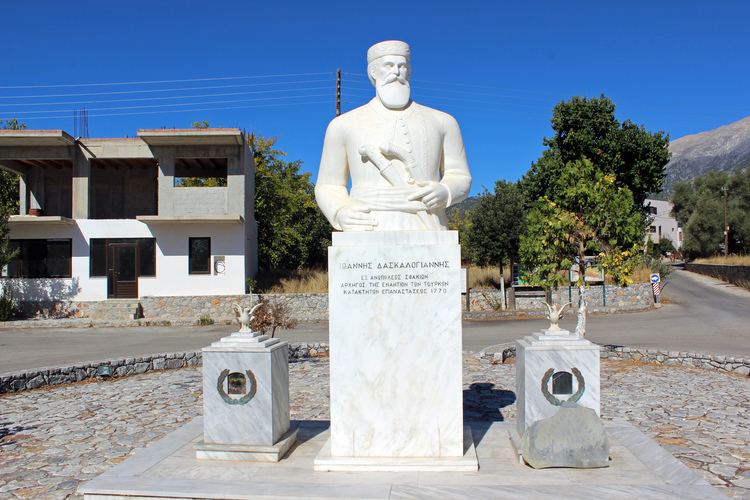Name Ioannis Vlachos Native name Ιωάννης Βλάχος | Allegiance Greece | |
 | ||
Nickname(s) DaskalogiannisΔασκαλογιάννης Died June 17, 1771, Heraklion, Greece | ||
Daskalogiannis cretan dance anopolis
Ioannis Vlachos (Greek: Ιωάννης Βλάχος), better known as Daskalogiannis (Δασκαλογιάννης; 1722/30 – June 17, 1771) was a wealthy shipbuilder and shipowner who led a Cretan revolt against Ottoman rule in the 18th century.
Contents
- Daskalogiannis cretan dance anopolis
- Anopolis daskalogiannis 2010
- Life and career
- Leader of revolt
- Legacy
- References

Anopolis daskalogiannis 2010
Life and career

Ioannis Vlachos was born in Anopolis village in Sfakia, a semi-autonomous region of Crete, in 1722 or 1730. His father, who was a wealthy shipowner, sent him to be educated abroad. Due to his education, his compatriots called him "Daskalos" (teacher), hence his nickname Daskalogiannis, "John the Teacher." He is referred to as a town clerk, in 1750, and chairman of the region of Sfakia in 1765, and as the owner of four, three-mast, merchant ships that sailed between the ports of the Mediterranean. These would have sailed from Prosyalo and the gulf of Loutro.

Daskalogiannis knew Emmanouil Benakis at Mani and it is likely that Benakis introduced him to Count Orlov who Catherine the Great had sent to the Peloponnese in 1769 to instigate a revolt there. Many men from Sfakia also participated in the revolt which Orlov instigated in the Peloponnese.
Leader of revolt
In early 1770, he was contacted by Russian emissaries, who hoped to instigate a revolt amongst the Greek subjects of the Ottoman Empire. Daskalogiannis agreed to fund and organize a rebellion in Sfakia against the Turkish authorities when the Russian emissaries promised to support him. In the spring of 1770, Daskalogiannis made preparations for the revolt at Sfakia; he brought together men, rifles, and supplies and had defenses built at strategic locations. However, the Russian fleet in the Aegean, under Count Orlov, did not sail for Crete, and the Cretan revolt was left to its own devices. The uprising began on 25 March 1770, with the flag raised at the church of Agios Georgios of Anopolis, and for a short time, parts of Crete had the attributes of an independent nation, including its own coins, minted in a cave near Hora Sfakion.
The coming winter was difficult because the Russian intervention, promised to Daskalogiannis, failed to materialize. The uprising did not spread to the lowlands, and without outside support, it was put down brutally by the superior Turkish forces of the island, who easily defeated the 1,300 rebels. Sfakia was for the first time fully dominated by Turkish forces. Daskalogiannis surrendered with 70 men at the castle of Frangokastello near Hora Sfakion. On the orders of the Pasha of Candia/Chandax (Heraklion), he was tortured outside Heraklion's harbor fortress, skinned alive, and executed οn 17 June 1771. He is said to have suffered the torture in silence. The Turks forced Daskalogiannis' brother to watch the torturous execution, which allegedly drove him insane.
Legacy
Daskalogiannis was immortalized in several folk tales and songs, the most prominent of which is the celebrated epic ballad by Barba-Pantzelios, a poor cheese-maker from Mouri - To tragoudi tou Daskalogianni of 1786:
…Φτάνουν στο Φραγκοκάστελο και στον πασά ποσώνου,κι εκείνος δούδει τ' όρντινο κι ευτύς τσοι ξαρματώνου.Ούλους τσοι ξαρματώσασι και τσοι μπισταγκωνίζουκαι τότες δα το νιώσασι πως δεν ξαναγυρίζου....They arrive at Frangokastello and surrender to the pasha,and he gives the order to disarm them at once.All of them were disarmed and ill at ease,for now they sensed that they would never go home.The war dance Pentozalis: The tradition says that before Daskalogiannis and his few men give the last battle against Ottomans danced Pentozali.
The international airport of Chania (CHQ/LGSA) bears Daskalogiannis' name. A memorial statue can be seen in his hometown Anopolis. One of the regular ferries in the Crete southeast routes is named the Daskalogiannis.
